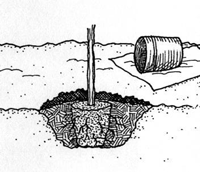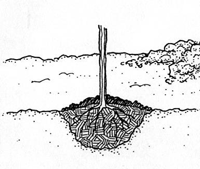Planting Containerized Trees
 |
Keep the soil in the container moist before planting. Set the pot with the tree still in it in the hole to confirm the correct depth. Then lift the tree out of the hole and remove the container from the rootball. Then set it back in position in the hole.
Often trees begin to outgrow their containers and become potbound. Compressed in a restricted space, roots wrap around the circumference the rootball, and are tangled and matted. If this is the case, pull or pry free as many roots as you can and spread them toward the edges of the hole when you set the tree in the hole. If they are terribly matted, you may have to clip some off or take a sharp knife and slice down vertically through the roots into the soil ball at 2 or 3 points around the rootball.
Planting Balled & Burlapped Trees
 |
When planting trees with roots and soilball wrapped in burlap, retain the burlap to hold the soilball firm while you set the tree in the hole and adjust its orientation and depth. When the tree is in its final position, open and cut away as much of the burlap wrapping as possible down and around the sides of the rootball. While natural burlap will eventually rot and allow lateral root growth, much of the burlap used today is synthetic and does not rot. Since it is difficult even for professionals to be sure its natural, make it a general practice to remove “burlap” wrappings.
Large trees often have a wire basket around their wrapped soilball with handles to help you lift and carry the tree. While you can leave some of the wire after you set the tree in place, cut away at least the upper one-third, including the top rim, to assure unobstructed lateral root growth. This will also make it easier to cut away most of the burlap within the wire basket.
Planting Bare Root Trees
 |
Be sure the roots of trees that are sold bare root stay moist until planting time. Then just prior to planting unwrap them and soak them in a pail of lukewarm water for an hour or two. Adding some plant tonic to the water is not essential, but it helps to fortify the plant against transplant shock. Clip off any broken or obviously dead roots.
Unlike container or balled and burlapped trees, bare root trees require a mound of packed soil at the bottom of the hole high enough to support the bare roots and establish the tree at the correct depth. Set the tree over this mound and check to be sure that its crown, the place where the roots join the main stem, is at or slightly above the surface of the surrounding soil.
In cases where the tree might be grafted, such as an apple or ornamental cherry, be sure the swollen graft is slightly above the soil line, unless the instructions that come with the plant indicate otherwise.
Some Thoughts About Bare Root Planting
When you want buy and plant a tree in your yard, you will usually go to a garden center or home center and buy one. It will come in a container or in a ball of roots wrapped in burlap. What most folks do not realize is that containerized or B&B trees are always more expensive than a tree that has its roots bare naked. What's more, according to the Urban Horticultural Center at Cornell University (http://www.hort.cornell.edu/UHI/), a bare root tree will establish itself in the soil more quickly than those other guys in clothes. The problem is that you can only buy bare root trees from a catalog or from, a tree nursery that specialized in selling bare root trees.
The simple complication in this whole discussion is that a tree that is dug up bare root, must be planted within a day or two or it must have some kind of wetting material surrounding it helping it to last maybe two weeks. The roots cannot be allowed to dry out.
But in the end, a bare root tree in good condition will be much cheaper than the others, will establish itself faster and more completely, and you can buy a two inch caliper and be able to move it around yourself. Two inch trees in containers or B&B may weigh over 200 pounds; more than this old man can handle. However, most nurseries sell bare root trees seldom bigger than one inch caliper. You have to find a wholesaler to get anything bigger. It is easy to find small whips of trees bare root in catalogs and on the Internet, but finding two inch caliper trees is not so easy.
You can find an outstanding brochure about how to plant a bare root tree and which species of trees are appropriate for bare root planting at http://www.hort.cornell.edu/UHI/outreach/pdfs/bareroot.pdf

